
When searching for available Livestock Guardian Dog breeds in the United States, one of the most critical things to consider is its function. Will he be a guard dog for livestock? If so, he must look intimidating and be gentle with stock. Is he going to be a family companion/ property guardian? If so, the dog must be from a breed that was traditionally used in this role and known to be affectionate and patient with family lifestyles. The breed of the Livestock Guardian Dog plays a vital role in its ability to function effectively in niche situations.
There are approximately 20 Livestock Guardian Dog breeds available in the United States and approximately 50 LGD breeds used worldwide. Livestock Guardian Dog colors are usually white, fawn, brindle, and pied, with black, grey, and sable being rare colors. They are universally large and powerful breeds with calm appearances and varying temperaments ranging from people soft to harder personalities.
In this article, we will talk more about the individual Livestock Guardian Dog breeds. This includes the different breeds of dogs, their rarity, how they look, and their most effective and original functions. You will also learn more about the distribution of colors and breed traits you can expect an LGD to have.
Each section also includes an “ideal for” verdict that highlights my recommendation for who the specific breed is best suited for. Let’s get started!
Which Livestock Guardian Dog breeds are available in the USA?
| LGD Breeds | Common Breed Traits |
| Akbash | Rare |
| Anatolian Shepherd | Very Popular |
| Armenian Gampr | Rare |
| Caucasian Ovcharka | Rare |
| Central Asian Shepherd (CAS) | Standard |
| Colorado Mountain Dog | Standard |
| Estrela Mountain Dog (Cao da Serra da Estrela) | Rare |
| Great Pyrenees | Very Popular |
| Kangal | Standard |
| Karakachan | Semi Popular |
| Kommondor | Semi Popular |
| Kuvasz | Rare |
| Maremma Sheep Dog | Popular |
| Pyrenean Mastiff | Standard |
| Sarplaninac | Standard |
| Sila Shepherd | Rare |
| Spanish Mastiff | Standard |
| Tatra Shepherd Dog | Rare |
| Tibetan Mastiff | Rare |
| Tornjak | Rare |
| Cao de Gado Transmontano | Rare |
| Sarabi Dog | Rare |
| Boz Shepherd ( A mix of Turkish Fighting breeds.) | Semi Popular |
Below is a deeper dive into the main LGD breeds available in the United States.
Akbash

The Akbash is a rare, white livestock guardian dog breed native to Turkey and originating in western Anatolia. The word akbas means “whitehead” and was given to the breed to distinguish it from the Karabas or “blackhead” native dog. The breed was only recognized by the Turkey Ministry of Agriculture Affairs in 2006. It is not recognized by the FCI.
The Akbash is a large dog, slightly resembling other LGD breeds from the Anatolia Region. It has a thick double-coated white coat that can have some biscuit shading. The breed weighs approximately 80-145 lbs and stands 20-34 inches tall.
Ideal for: Serious predator control where a grittier dog than the softer BWD breeds is needed. Thrives on western ranch type properties. Not recommended for first-time dog owners or people who do not wish to have a serious guard dog. The Akbash dog needs a firm, but calm, confident, consistent owner.
Anatolian Shepherd

The Anatolian Shepherd dog is the AKC-recognized version of the Kangal Copegi from the Anatolia Region in Turkey. They are not recognized as a breed by their native country, but are comprised of a mix of LGD shepherd breeds in the Anatolia Region. They are large and functional dogs available in both short-haired and rough-haired versions. The Anatolian stands between 27-29 inches at the shoulder and can weigh up to 150 lbs. They are able to handle large predators and are often used on larger acreage in the western United States.
- Their personalities tend to be serious, intense, and devoted.
- They need an experienced dog owner and secure boundaries.
- They are not ideal for small, urban acreage.
- They will not accept strangers unless they receive the owner’s permission.
- They have more prey drive than some of the other LGD breeds/may need extra poultry training.
- Are very loyal to stock when acclimated properly.
- One of the popular working Livestock guardian dog breeds in the United States.
Ideal for: Homesteads, farms, and ranches that have a need for an imposing guardian dog. These dogs do very well in environments where they have a job to do. Ideal for the varied geographical regions in the United Stated, but are not suited to urban homes. They are ‘alot’ of dog for first-time dog owners and are only recommended for first-time dog owners if the breeder is willing to mentor the dog and owner. Are not recommended for agricultural tourism farms.
Armenian Gampr

The Armenian Gampr is a landrace breed native to the Armenian Highlands. The Gampr falls within the Ovcharka group of livestock guardian dogs. It was recognized in 2011 by the International Kennel Union in Moscow, under the guidance of the Armenian Kennel Club, which developed the breed standard in the 1990s.
- The breed is a smart, effective, and independent breed that is commonly used for livestock guarding jobs.
- They bond well with their humans, but require a fair and experienced owner.
- The breed enjoys patrolling and will display both perimeter and interior flock guardian tendencies.
Characteristics
The breed has a very strong work ethic but comes with the typical sharp, quick escalation characteristics of Russian LGD-type breeds. They will alert to noise, predators, and strangers. The working lines are very instinctive and known to be gentle and protective of stock with zero tolerance for predators and intruders. The more modern lines are primarily fighting bred and not suitable for homesteading or LGD lifestyles.
The Gampr may vary in temperament due to its landrace quality and the recency of its classification as a breed. But quality gamprs are said to be excellent with family members and livestock, but not suitable for environments with visitors. Gamprs may be slightly smaller than some of their breed group cousins. They range in the 80-120 lb weight range and stand up to 25 inches tall at the withers. They also vary in color and almost any color is permissible except blue or merle. Roughly 15% of Gamprs are born with a natural bobtail. This can be as short as two vertebrae or sometimes a 3/4 tail. Most Gampr ears are docked.
Ideal for: The Gampr is ideal for livestock protection jobs where they are allowed to work in a secure environment without intrusion from human strangers. This breed can become a liability if not given the right setting and management. They require an experienced, fair owner and excel as predator deterrents and property guardians when bonded to stock.
Caucasian Ovcharka

One of the toughest dog breeds in the LGD breed group is the Caucasian Ovcharka. They are a breed created in the Soviet Union to fight Russian bears and used in the Russian military and as prison guards. The breed originated as a large livestock guardian in the Caucasus region. Caucasian shepherd dogs from Georgia were considered to be the most impressive examples of the breed due to their size, powerful musculoskeletal structure, and attractive long hair. For this reason, the Georgian SSR became a principal region of cultivation of Caucasian Shepherd Dogs in the Soviet Union.
The breed is banned in some European countries and has been subject to certain restrictions in Russia. The Ovcharka breed is responsible for some of the deadliest dog attacks recorded and is not a breed to underestimate or to be owned by amateurs.
Ideal for: The Caucasian Ovcharka needs a high predator load, a very experienced dog owner, and a secure environment to work in. This breed has a temperament too aggressive and stubborn to be suitable for a high percentage of the livestock guardian dog owners and properties that require guardians in the United States. They need secure fencing, and a high predator load to thrive.
Central Asian Shepherd

Central Asian Shepherds were developed for both livestock and personal protection. They are a hardworking LGD breed with a quick escalation trigger known to be very suspicious of strangers. They are used in Central Asia for many protection purposes for both livestock and property.
The breed is not as stock sticky as some breeds, they are a diverse working style breed like many of the OG Livestock Guardian dogs. Some of the dogs will gravitate towards perimeter guarding while other CAS are content to guard closely with their charges. Maintaining fences is a must, as a CAS will want to drive predators far away from their territory and will make an impressive roar and show while doing it. The CAS is a breed known for its barking and its reputation for engaging quickly with predators that do not respect its warnings. They are very formidable and have a high work ethic, endurance, and a natural instinct for territory.
Appearance
The Central Asian Shepherd is one of the only LGD breeds in America that features black as an accepted color. The current acceptable colors of the CAS are black, brindle, fawn, grey, and white. Breed description quoted from the original FCI standard: The Central Asian Shepherd Dog features a robust, muscular body, of large stature but not with visible muscles. Males are larger than females and full maturity is reached by 3 years of age.
Ideal For: CAS is ideal for fenced/gated properties, as well as properties with zero tolerance for visitors that require legitimate predator control.
These dogs are not ideal for homesteads where there are a lot of people visiting and working. This breed is normally excellent with small children and animals and devoted to its family. But it has a quick trigger for escalation and needs a secure environment to thrive in and protect.
Colorado Mountain Dog

Colorado Mountain Dogs are a breed still in a developmental stage.
Pros: This breed acknowledges the working, landrace LGD breeds of the United States that largely are not papered elsewhere. The open stud book promotes diversity and the breed founders have been actively promoting using working LGD foundation stock. The breed has the potential to fill a valuable landrace LGD niche.
Cons: Almost any LGD gene blend can qualify as a CMD foundation dog, making individual dogs vastly different from each other. One litter of CMD puppies may not be at all like the CMD litter on the next farm. The breed foundation has also confusingly advocated removing specific and significant LGD traits from their lines, potentially creating a dog that is unable to fulfill its job as a well-balanced guardian.
The concept of a Landrace American LGD has significant potential. By removing certain characteristics of the original prototype LGDs, it is difficult to determine what the breed intends to achieve.
Ideal for: Small homesteads without significant Apex predator loads. Due to the variation among the breeds used as foundation stock, it is difficult to say what they will be suitable for.
Estrela Mountain Dog – Cao da Serra da Estrela

The Estrela Mountain Dog originated in the Serra de Estrela Mountains in Portugal. In addition, they are similar to their other LGD cousins in being one of the oldest dog breeds known to mankind. They were one of the first LGD breeds recognized by the FCI along with the Great Pyrenees, Pyrenean Mastiff, and Sharplanintz. While this LGD breed was mostly forgotten by modern society until recently, it still serves as a herd guardian and companion in its native country. Sierra da Estrela is available in 2 coat lengths: short-haired and long-haired. In addition to being highly functional, both coat lengths are very accepted and celebrated. The indigenous Sierra is calm and gentle but has the fortitude and determination to handle large predators.
Modern vs Indigenous Serra da Estrelas
Some of the modern Leonberger-type Estrela Mountain Dogs have lost their stock instincts. This type is most often seen in show kennels and should not be confused with the indigenous Serra. In comparison to the original Serra da Estrela dogs, these dogs possess a higher prey drive and have a less pleasant attitude. To experience the true Serra da Estrela, seek out native working lines.
The indigenous Sierra is calm and gentle but has the fortitude and determination to handle large predators. They are commonly used in herds accompanied by shepherds and desire human companionship. It is important that these dogs have a well-balanced, empathic nature, even though they are very effective at discouraging intruders.
They are more biddable than some of the LGD breeds, they have a big bark, and they can be suspicious of strangers.
Ideal for: Families and homesteads that need a dog capable of handling predator loads without the quick escalation of the Russian-type LGD breeds. This breed is able to handle visitors and tourist ag environments if the owner socializes the breed. They are capable of protecting large property areas, but they enjoy watching over smaller properties as well. They will bark at night if left outside and are not suited to neighborhoods where noise ordinances are anti-LGD.
Great Pyrenees

The Great Pyrenees is probably the most famous LGD breed in the United States. The breed has faced criticism for its loss of working instincts, but the original, working Great Pyrenees was great for a reason. Most of the BWDs ( big white dogs ) in the LGD community tend to be Great Pyrenees and they were the first popular LGD here.
When I first moved here, I remember my neighbor telling me they were getting some big white sheepdogs. According to rumor, they lived right with the sheep, ate grass with the sheep, and never needed humans. I remember how futile it was to try and persuade these new owners that the dogs would indeed require regular dog food and other common sense canine QOL practices. This breed was essentially the training wheels of LGDs for many American homesteads, and they certainly paved the way for the LGD culture here to persist.
The working Great Pyrenees is still a formidable guardian against predators while being affectionate and soft with its humans. The GP has a reputation for wandering and barking, but this is true of any LGD breed. As a result of mass puppy production on farms where the breed was only used as an ATM rather than as an effective Guardian, the breed’s working ethics have been affected in a negative way. This was a serious disservice to the breed and something they certainly never deserved.
How do you choose a working Great Pyrenees dog?
Look for:
- Puppies from actual working lines
- Health-tested, functional breeding stock
- Functional coats – not the cotton candy show coat
- A breeder who understands the original functions.
The Great Pyrenees fills a large niche in today’s homesteading communities. The GP has the self-control and the work ethic needed to function on farms where dogs with sharp personalities become a liability. A softer BWD who is still able to perform adequate predator control is a necessary and socially conscious choice in many situations.
Ideal for: Families with young children and first-time LGD owners that can benefit from getting an owner soft dog. Farms with free-range poultry, agricultural tourism, and other environments where people come and go (owner supervision required).
Kangal Shepherds

The Kangal Shepherd ( Kangal Coban Kopegi ) is a Turkish breed of livestock guardian dog that is known for its impressive strength and size. This traditional flock guardian dog is respected worldwide. They are known for their serious work ethic, muscular frame, and the most powerful bite of all domestic dogs. With a bite force of 743 PSI, this breed is able to protect stock against a wide variety of large predators.
Around 300 of the Kangal dogs have been sent to farmers in Namibia and Kenya since 1994 by the Cheetah Conservation Fund to defend livestock from cheetah attacks. Since then, the number of cheetahs killed by farmers is calculated to have fallen from 19 per farmer annually to 2.4. Livestock losses have been cut significantly at more than 80% of the farms where the dogs have been adopted. Kangals have been the foundation block of many LGD predator solutions worldwide, and deserve the reputation they enjoy today.
Kangal Characteristics and Traits
The Kangal has an aesthetic appearance and a determined and hardworking attitude. They are happy with a big job to do, under an experienced dog owner. The Kangal LGD was the go-to for large predator protection all across the globe. They look intimidating enough to deter predators and strangers but tend to be gentle and patient with their charges.
The fighting lines of Kangal should be avoided for LGD work. They no longer exhibit a working instinct and can become a liability for their owners.
The Kangal is not recognized by the AKC. In the United States, the Anatolian Shepherd Breed is the version of the Kangal that is most readily available. Turkish culture considers Anatolians a mixed breed race and does not recognize the Anatolian breed as a breed. Some of the Anatolian shepherds in the United States do resemble their formidable Kangal roots, and others resemble other Turkish dog breeds.
How Big Is a Kangal?
The Kangal Shepherd is a large and agile breed, not as heavy as some of the other mastiff breeds. The dogs are fast and powerful, able to reach speeds of 35 mph and holding the world record for strongest bite force. The height of male dogs ranges from 28 to 31 inches, and the height of female dogs ranges from 26 to 29 inches. Their weight ranges between 110 and 145 pounds, and they have very little body fat. Most of their mass is comprised of bone and muscle. Traditionally the Kangal is known to range inc color from fawn to grey, with black masks.
Ideal for: Farms and agriculture ranches can benefit from the imposing, stock-friendly, and predator-intimidating attitude of the Kangal. They do best with lots of space and secure fencing and are not suitable for tourism farms. They need a big job to do, and an experienced dog owner to provide them with the working environment they deserve.
(To be concluded….)
Related Posts You May Like:
Comments +